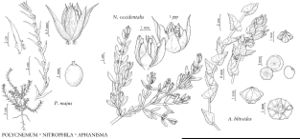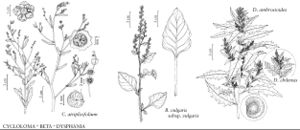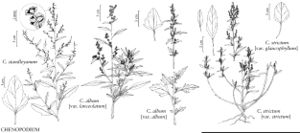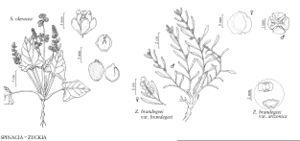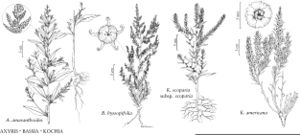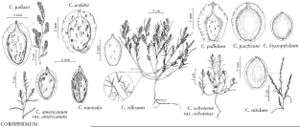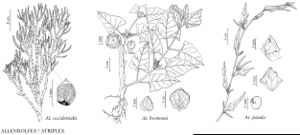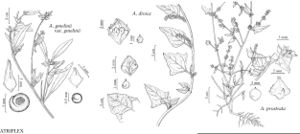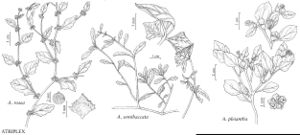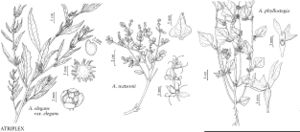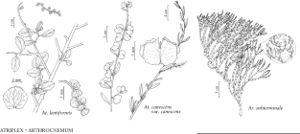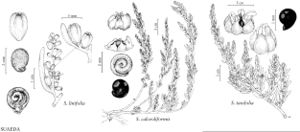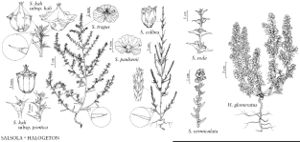Herbs, shrubs (rarely small trees), annual or perennial, monoecious, dioecious, or polygamous, evergreen or deciduous. Roots fibrous, taprooted, sometimes fusiform or bulbous, fleshy and thickened in Beta. Stems sometimes succulent and apparently jointed, or with slippery and aromatic bark, sometimes spiny, alternate or opposite; pubescence silvery, sometimes stellate or glandular, often scurfy from inflated salt glands that senesce into white flakes. Leaves simple, usually alternate, occasionally opposite, lacking stipules, petiolate or sessile, sometimes reduced to small scales, or fleshy; blade linear to broadly triangulate in outline, margins entire to serrate, serrate-dentate, or lobed. Inflorescences: flowers solitary or clustered in axillary or terminal glomerules or in short, cylindric spikes; bracts absent or 1–5, deciduous or persistent, of various shapes. Flowers bisexual or unisexual, uniseriate, radially or rarely bilaterally symmetric; bracteoles absent or 1–5, connate basally, green; perianth segments 5, sometimes 1 or absent, green, inconspicuous, fleshy in Salicornia and Sarcocornia, strongly imbricate in Nitrophila; petals absent; stamens absent or 1–5, usually as many as and opposite perianth lobes; pistils absent or (1–) 2 (–3); styles 1–3, sometimes with stylopodium; ovary usually superior, half-inferior in Sarcobatus, inferior and connate with receptacle in fruit in Beta, 1-locular with single, basally attached ovule. Fruiting structures: bracteoles or fruiting bracts brown, black, or reddish-brown, monomorphic or sometimes dimorphic; perianth segments deciduous or persistent in mature fruits and of various shapes and ornamentation, accrescent around fruits; fruits achenes or utricles, vertical or horizontal within perianth parts, pericarp (ovary wall) adherent or nonadherent, chartaceous or papery, sometimes reticulate, mottled or smooth. Ovules usually 1, campylotropous, bitegmic, crassinucellate. Seeds 1 per flower, black, brown, reddish-brown, or mixture, flattened vertically or rounded, margins winged or not winged, surfaces smooth and shiny or reticulate, regulate, verrucate, prickly, or indistinct, morphology variable and strongly influenced by plant photoperiod; seed-coat smooth, striate, or verrucate when pericarp removed; embryo large, curved to annular or spirally coiled; radicle position median or basal, ascending or pointing outward; endosperm usually digested by developing embryo and food storage taken over by perisperm. x = 9. Polyploidy common.
Distribution
Worldwide, especially in desert and semidesert regions, often in alkaline or saline habitats
Discussion
Genera ca. 100, species ca. 1500 (27 genera, 168 species in the flora).
A number of species introduced from Europe and Asia are weedy in North America. The widespread distribution of the family in the deserts of Eurasia and Australia is indicative of the ancient status of the family. Fossil pollen from this family dates to the Maestrichtian, providing the oldest known fossils in the Caryophylliidae.
Plants in this family typically have Crassulacean Acid Metabolism, have either a C3 or C4 photosynthetic pathway (W. V. Brown 1975; G. W. Welkie and M. Caldwell 1970), accumulate organic acids, free nitrates, and oxalates, and often contain alkaloids. Along with other members of the Caryophyllales, members of the family contain pigments called betalains (named for the genus Beta) rather than anthocyanins.
Economically important members of this family include spinach and chard (Spinacia oleracea) and beets (Beta vulgaris). Seeds in this family generally provide a rich source of protein, and one species, Chenopodium quinoa, is gaining widespread acceptance as a cereal crop. Toxicity from high levels of nitrates or oxalates has been reported for a number of species (J. M. Kingsbury 1964), and the pollen is known to be allergenic (T. C. Fuller and E. McClintock 1986). The nutritional characteristics of many species that we share with northern Asia were described by M. M. Iljin (1936).
Molecular and morphologic studies provide evidence supporting the inclusion of the Chenopodiaceae within Amaranthaceae (Angiosperm Phylogeny Group 1998; W. S. Judd and I. K. Ferguson 1999; J. E. Rodman 1990). However, until discordant elements within these lineages, such as Sarcobatus (H.-D. Behnke 1997), are interpreted within a larger evolutionary scheme, the disposition of family groups remains problematic.
Selected References
Lower Taxa
Illustrations
Key
| 1 | Leaves scalelike; stems fleshy or succulent; plants of saline habitats | > 2 |
| 1 | Leaves well developed, not scalelike; stems not fleshy (except Arthrocnemum, and Sarcocornia, which is fleshy when young); plants of various habitats | > 5 |
| 2 | Leaves alternate | Allenrolfea |
| 2 | Leaves opposite | > 3 |
| 3 | Plants annual herbs; all stems terminated by an inflorescence | Salicornia |
| 3 | Plants perennial shrubs; many stems entirely vegetative | > 4 |
| 4 | Flowers distinct in each cyme, not adnate; outer seed coat hard, tuberculate | Arthrocnemum |
| 4 | Flowers of each cyme adnate to distal branch of inflorescence; outer seed coat thin, covered with hooked or straight hairs | Sarcocornia |
| 5 | Leaves opposite; perianth strongly imbricate | Nitrophila |
| 5 | Leaves alternate, rarely opposite; perianth slightly, if at all imbricate | > 6 |
| 6 | Inflorescence leaves or bracts tipped with spine or spinelike bristle | > 7 |
| 6 | Inflorescence leaves and bracts not tipped with spine or bristle | > 9 |
| 7 | Leaves triquetrous, triangular in cross section, terminating in soft or rarely rigid, flattened bristle | Polycnemum |
| 7 | Leaves terete or flat in cross section, terminating in stiff, mucronate spine tips or bristle | > 8 |
| 8 | Fruiting perianth abaxially winged; leaves linear to subulate, herbaceous or fleshy, spine-tipped or not; bracts of inflorescence ovate-lanceolate, spine tipped | Salsola |
| 8 | Fruiting perianth apically winged; leaves terete, fleshy-succulent, bristle- tipped; bracts of inflorescence similar to leaves | Halogeton |
| 9 | Leaves sub- or semicylindric to linear, usually fleshy | > 10 |
| 9 | Leaves with flattened blades, not especially fleshy | > 12 |
| 10 | Shrubs armed with thorny branches; flowers unisexual, staminate flowers in spikes, pistillate flowers solitary or paired and axillary | Sarcobatus |
| 10 | Shrubs or herbs, not armed; flowers bisexual or both bisexual and pistillate, solitary or 2-5 in axillary clusters | > 11 |
| 11 | Fruiting perianth developing horizontal, membranceous wings or tubercles; leaves herbaceous | Kochia |
| 11 | Fruiting perianth without wings or tubercules, unchanged from flowering peri- anth; leaves fleshy | Suaeda |
| 12 | Plants stellate-pubescent annual herbs | Axyris |
| 12 | Plants glabrous, farinose, or with dendritic hairs; if the latter, then plants woody perennials | > 13 |
| 13 | Plants densely tomentose with at least some stellate hairs becoming golden brown in age, subshrubs | Krascheninnikovia |
| 13 | Plants hairy or glabrous, not as above, shrubs or herbs | > 14 |
| 14 | Pistillate flowers usually lacking perianth, at least some flowers enclosed by 2 accrescent or connate bracts in fruit; flowers unisexual or, rarely, bisexual | > 15 |
| 14 | Perianth present, not enclosed by paired bracts in fruit; flowers bisexual or unisexual (Micromonolepis) or some also pistillate | > 19 |
| 15 | Stigmas 4 or 5; plants cultivated herbs | Spinacia |
| 15 | Stigmas 2; plants not or seldom cultivated | > 16 |
| 16 | Bracts (or bractlike perianth segments) dorsally compressed, usually triangular, smooth, tuberculate, vertically keeled, or winged; pubescence usually of inflated hairs or, sometimes, none; axillary rounded buds absent or inconspicuous | > 17 |
| 16 | Bracts laterally compressed, keeled, or winged, lacking appendages; pubescence of simple or branched hairs | > 18 |
| 17 | Bractlike perianth segments united below middle, vertically keeled; plants annual | Suckleya |
| 17 | Bracts united above middle, not vertically keeled; plants pe- rennial or annual | Atriplex |
| 18 | Shrubs with divaricate, often spinescent branches; bracts with margins thickened, spongy within; pubescence of branched hairs | Grayia |
| 18 | Shrubs with erect thornless branches; bracts with margins not spongy-thickened, either obcompressed or dorsiventrally compressed and 6-ribbed; pubescence of scurfy or moniliform hairs | Zuckia |
| 19 | Perianth horizontally winged in fruit | > 20 |
| 19 | Perianth not horizontally winged in fruit | > 21 |
| 20 | Leaf blade margins sinuate-dentate; plants ± villous or tomentulose, becoming glabrous with maturity | Cycloloma |
| 20 | Leaf blade margins entire; plants usually glabrous, sometimes slightly pubescent | Kochia |
| 21 | Proximal leaves petiolate, middle ones merely sessile, distal ones cordate-clasping; style branches 3 | Aphanisma |
| 21 | Leaves not as above; style branches mainly 2 | > 22 |
| 22 | Perianth segments each armed with spiniform, hooked, or conic appendages | Bassia |
| 22 | Perianth segments rounded or keeled abaxially, lacking wings or spines | > 23 |
| 23 | Ovary partly inferior; plants cultivated, rarely naturalized | Beta |
| 23 | Ovary superior; plants native or naturalized, not cultivated | > 24 |
| 24 | Perianth lobes 5, largely enfolding and concealing to exposing fruits; stamens usually 5 | > 25 |
| 24 | Perianth lobes 1-3 or absent; fruits largely exposed; stamens 1-3(-5) | > 26 |
| 25 | Plants (at least some parts) with glandular or glandular-vesicular hairs | Dysphania |
| 25 | Plants farinose or glabrous | Chenopodium |
| 26 | Plants dichotomously branched, ultimate branches filiform; leaves oblong, succulent | Micromonolepis |
| 26 | Plants not dichotomously branching, ultimate branches not filiform; leaves triangular-lanceolate to oblanceolate, spatulate, or linear | > 27 |
| 27 | Leaves triangular-lanceolate to oblanceolate or spatulate; perianth segments usually 1 (2-3 segments in central flowers); stamens usually 1; plants widespread, of many habitats | Monolepis |
| 27 | Leaves lanceolate, linear-lanceolate, or filiform; perianth segments 1-3; stamens 1-3(-5); plants of sandy, low elevation sites. | Corispermum |
